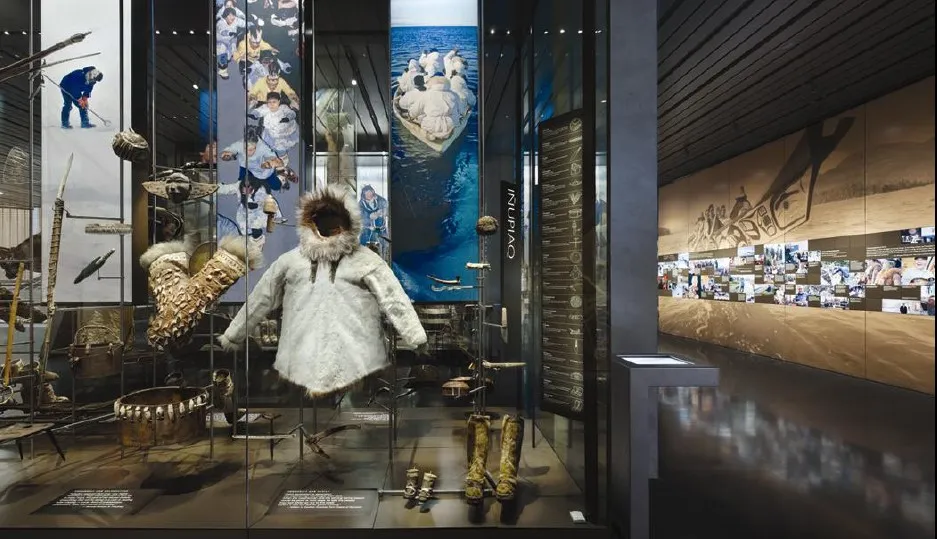NATIONAL MUSEUM OF NATURAL HISTORY
How Arctic Anthropologists are Expanding Narratives about the North
Researchers are studying past Arctic cultures and working with today’s northern communities to address present-day socioeconomic and environmental challenges.
:focal(538x387:539x388)/https://tf-cmsv2-smithsonianmag-media.s3.amazonaws.com/blogging/featured/Ivory_figurines_of_a_seal_walrus_and_beluga_whale..jpg)
After even one month of cold, snow and ice, the wintery landscape seems dreary and bleak. But appearances are deceptive — and no place is better proof of this fact than the Arctic, where people have lived for over 30,000 years.
"This is a unique part of the world because it’s the only place where you have such similar environments in animals, resources and cultures,” said Dr. William Fitzhugh, curator of North American archaeology and director of the Arctic Studies Center at the Smithsonian’s National Museum of Natural History. "The rest of the world is divided by vast oceans which restricted communication until recent times.”
By combining archaeology, ethnology and climatology with other natural sciences, researchers at the Arctic Studies Center are learning more about diverse ancient Arctic cultures and working alongside today’s northern communities to address present-day socioeconomic and environmental challenges.
“The Arctic Studies Center is not about doing research in distant places on exotic people. It is a nexus where we study natural history, environmental history and cultural history by looking at all of those elements at once,” said Dr. Igor Krupnik, the chair of anthropology and curator of circumpolar ethnology at the museum.
A rich history of many nations
People in the United States grow up learning about the Arctic primarily in the context of Alaska. But that region is only part of the globe’s entire Northern circumpolar area, and the people who inhabit those regions, the Inuit and the Unangax (Aleut), are but two of many northern nations.
“One of the strengths of the Arctic Studies Center is that we represent the knowledge about this entire group of Indigenous nations. We're not the North American Arctic Studies Center,” said Krupnik.

In addition to North American nations, there is the European Arctic which includes the Sámi in Norway, Finland and other countries. The Russian Arctic also has around 40 Indigenous nations like the Chukchi, and the Nenets.
For thousands of years, these nations have developed complex trade and migration networks just like societies in less cold parts of the world.
“The Arctic was seen as a relatively inaccessible place as far as European societies were concerned. But archaeological work has shown that it has an ancient, ancient history,” said Fitzhugh. “That history shows how people have lived in the Arctic and gone through a series of cultural changes and economic and technical revolutions of their own long before European contact.”
But those systems were initially overlooked when people started studying Arctic anthropology in the 1800s. Scientists mistakenly saw the Arctic nations as primitive and exotic, removed from the so-called modern problems of European society, like socioeconomic growth or urbanization.
“Anthropology was originally the science of studying distant and exotic people. It was a colonial science. But the Arctic actually gives us a window into lives of our co-citizens, who reside in the North,” said Krupnik.
Updating Arctic narratives
/https://tf-cmsv2-smithsonianmag-media.s3.amazonaws.com/filer_public/92/02/9202e36c-a7eb-42da-a9be-c93d9d417223/an_exhibit_display_for_a_narwhal.jpg)
Krupnik, Fitzhugh and their colleagues are working together at the Arctic Studies Center to expand the traditional narrative of the Arctic. Fitzhugh, an archaeologist, explores the museum’s Arctic collections to piece together more about past communities while Krupnik collaborates with local communities and international scientists to record modern Arctic change. The two began their collaboration in the 1980s and joined forces in 1991, just three years after the center was founded.
“The Arctic is a very unusual place where you can use a combination of archaeology, biology, climatology, history and more, which all converge on an area where you have a lot of shared content,” said Fitzhugh.
The program also has an Alaska office in the Anchorage Museum headed by Dr. Aron Crowell, which hosts exhibitions, educational programming and collaborative research with Alaska Natives communities. One example of such an exhibit is the ongoing “Living Our Cultures, Sharing Our Heritage: The First Peoples of Alaska.”
“One of the major reasons we started the Alaska office was to provide access to Smithsonian collections that had been gathered from among their ancestors, and were exhibited and stored in Washington DC for the last 150 years, that they had never seen,” said Fitzhugh.
In the years since the Alaska office’s opening in 1993, the Center has also begun to look towards the Arctic’s future. Researchers are collaborating with local communities who are currently navigating challenges like climate change, language preservation, public health emergencies from COVID-19 and other issues of the day.
“Culture is a life-sustaining force like food and social life. It nurtures you and gives meaning to life,” said Fitzhugh. “By preserving the knowledge about the past, we are helping prepare Alaskans and other northern peoples for the uncertain future of climate change.”
“It's important not to exoticize people’s responses to any of these challenges,” said Krupnik. “Ethnology in the Arctic is recognizing that people’s lives are affected by many factors…. What we are interested in is helping them make their voices heard.”
Related Stories:
Meet the Scientist Studying How Cellphones Change Societies
What Chocolate-Drinking Jars Tell Indigenous Potters Now
Convergence May Help Scientists Predict the Future
Some Archaeological Dating can be as Simple as Flipping a Coin
Is 3D Technology the Key to Preserving Indigenous Cultures?

